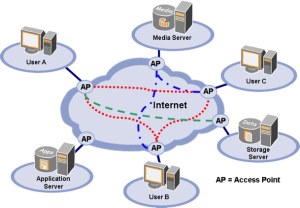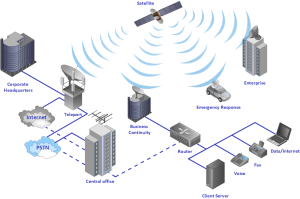The susceptibility of wireless communication systems to various impairments like fading, interference, and noise can lead to a significant deterioration in signal quality. To alleviate these effects and bolster performance, diversity techniques have been implemented.

Out of the numerous diversity techniques available, antenna diversity reigns supreme as one of the most widely used methods in wireless communication. By introducing multiple antennas at both ends of transmission, it is possible to tackle fading caused by multipath propagation head-on. Space diversity takes this approach even further by incorporating several receiving antennas placed at different locations to reduce fading.
Moreover, time diversity serves as another popular scheme that involves transmitting redundant copies of data over distinct time slots or frequencies. This technique works wonders in mitigating errors caused by bursty channel conditions and improving overall system reliability. Frequency diversity also proves useful when dealing with frequency-selective fading since it spreads data across multiple subcarriers or channels.
All things considered, diverse techniques play an indispensable role in enhancing wireless communication performance as they counteract various forms of impairment such as fading, interference, and noise. Antenna diversity alongside space diversities are some common approaches utilized for this purpose along with time-diversity and frequency-diversity being other viable options to consider!
Antenna Diversity for Improved Wireless Communication
Contents
- 1 Antenna Diversity for Improved Wireless Communication
- 2 Space Diversity in Wireless Communication
- 3 Time Diversity Techniques for Wireless Communication
- 4 Frequency Diversity Techniques for Wireless Communication
- 5 Pattern Diversity Techniques for Improved Wireless Communication
- 6 Polarization Diversity Techniques in Wireless Communication
- 7 Selection Diversity Techniques for Improved Wireless Communication
Antenna diversity, a fascinating technique employed to enhance wireless communication, offers an array of benefits that can leave one in awe. By utilizing multiple antennas at the receiver end, signal reception is considerably improved in areas where signals may be feeble or subject to fading – a godsend for mobile communication systems as signal strength tends to fluctuate wildly depending on location.

The concept behind antenna diversity is relatively straightforward; by utilizing several antennas, the receiver can choose the best one based on current conditions. This approach helps reduce interference and other forms of degradation that impact signal quality significantly. There are various types of antenna diversity schemes available today, including pattern diversity and polarization diversity – each with its unique advantages.
What sets antenna diversity apart from other techniques is its cost-effectiveness and simplicity since it doesn’t require any additional RF hardware beyond what’s already present in most wireless communication systems. However, note that while this method may help mitigate some sources of fading and interference, it may not provide a complete solution for all potential sources of signal degradation – perplexing indeed!
Space Diversity in Wireless Communication
The intricacies of wireless communication are often perplexing, but none more so than the space diversity technique. This enigmatic approach employs multiple antennas that are strategically spaced apart to combat the perils of fading. The use of this diversity scheme is paramount in improving both the reliability and quality of wireless communication by curbing signal loss caused by multipath interference.
Antenna diversity plays a pivotal role in space diversity, as it enables signals to be received from various angles. This allows for optimal selection or combination of signals via a combiner, resulting in a dominant overall signal. Antenna diversity also proves useful in mitigating different types of fading such as Rayleigh and Rician fading.
Frequency diversity is another mystical aspect of space diversity that utilizes various frequencies to transmit data over a wireless system simultaneously. By leveraging disparate frequencies concurrently, frequency selective fading can be minimized, thereby enhancing overall performance. To take things up another notch, time and polarization diversities can also converge with space diversity for even greater advancement in wireless communication quality.
Time Diversity Techniques for Wireless Communication
The intricate world of wireless communication systems boasts a diversity scheme that has left many in awe: time diversity. This dynamic technique involves transmitting multiple copies of the same signal at different times over the same channel, all in a bid to combat the dreaded multipath fading. The latter occurs when signals from the transmitter reach the receiver through different paths and interfere with each other – talk about chaos!
One type of time diversity that’s gaining popularity is selection diversity, where only one copy of the signal gets transmitted at any given time. It’s like playing musical chairs with your transmission-who will get selected? The base station or receiver decides which copy to transmit based on received signal strength or SNR (signal-to-noise ratio). And if you thought selection was impressive enough, wait till you hear about combining it with antenna or polarization diversity for an even greater improvement in performance.
Zooming into microscopic diversity reveals how small variations in transmission parameters such as frequency or phase are introduced between different copies of the signal-what sorcery is this?! But these “variations” help combat interference caused by adjacent channels and allow for more efficient use of available bandwidth. Who knew that something so minute could have such a huge impact?
Overall, it’s clear that time diversity techniques are not here to play-but rather to improve wireless communication performance and reduce errors caused by multipath fading. Let’s just say this field keeps getting more intriguing every day!
Frequency Diversity Techniques for Wireless Communication
The perplexing nature of wireless communication in fluctuating environments can often leave one feeling overwhelmed and uncertain. However, fear not! Frequency diversity techniques offer a burst of hope to improve this precarious situation. By transmitting the same signal at different frequencies, the wireless link becomes less susceptible to deep fades or a complete loss of signal strength due to propagation effects. Each frequency experiences unique large-scale fading and small-scale fading that can be tamed by using multiple receiving antennas.
To implement frequency diversity, one common method is through orthogonal frequency-division multiplexing (OFDM). OFDM divides the total bandwidth into numerous subcarriers spaced apart by a fixed wavelength. Each subcarrier carries data at varying times, enabling efficient use of available spectrum while providing redundancy against interference and noise. Equalizers then compensate for any distortion caused by selective attenuation or phase shifts in the signal path.
Another approach involves using multiple-input multiple-output (MIMO) technology with two or more antennas on both ends of the wireless link that combine signals received from each antenna to enhance overall performance and reduce errors due to interference or multi-path propagation. In MIMO systems, polarized antennas should be selected so they receive signals from slightly different directions, minimizing coherence between them.
By employing these techniques alongside other forms of diversity such as space and pattern diversity, cellular networks achieve reliable high-speed data transmission over long distances without sacrificing quality or reliability. Whether streaming video on your smartphone or conducting business on your laptop, understanding how frequency diversity works is essential for maintaining a strong wireless connection no matter where you go!
Pattern Diversity Techniques for Improved Wireless Communication
The baffling nature of wireless communication has been a topic of discussion for quite some time. Antenna diversity, although widely used to improve it, presents certain challenges in scenarios where signal shadowing or small-scale fading due to multi-path propagation is experienced. The introduction of pattern diversity techniques has therefore come as a welcome relief.
Pattern diversity involves the use of multiple antennas with different radiation patterns to obtain spatial diversity. This technique works by taking advantage of the time-varying nature of the channel which causes signals received at each antenna to be different, thus enabling multiple copies of transmitted signals. Mobile communication systems that have limited coherence time and bandwidth stand to benefit greatly from this approach.
Polarization diversity is yet another form of pattern diversity that utilizes differently polarized radiated fields from multiple antennas. By doing so, additional paths for signal transmission are created resulting in improved signal quality upon reception. A combiner then comes into play by exploiting training sequence information from each antenna’s received signal and combining them into one coherent output.
In summary, pattern diversity techniques offer an invaluable solution for improving wireless communication performance when other forms such as space and frequency cannot be effectively utilized due to various limitations like shadowing effects or small-scale fading conditions. By utilizing diverse antenna patterns and polarization states, extra paths for transmitting signals can be obtained leading to an overall improvement in system reliability and capacity – truly perplexing but beneficial indeed!
Polarization Diversity Techniques in Wireless Communication
Perplexingly, polarization diversity is a technique that’s been adopted by many wireless communication systems to enhance signal quality. This enigmatic concept of diversity mandates multiple versions of the same signal to be transmitted through different channels, and polarization diversity does this using antennas with orthogonal polarizations. As depicted in the figure, two antenna elements are utilized for receiving signals from disparate directions.
The unparalleled advantage of polarization diversity is its ability to expose the wireless system to diverse types of fading. In frequency selective fading, specific frequencies may suffer more attenuation than others; whereas small-scale Rayleigh fading can bring about rapid fluctuations due to various factors like interference. By utilizing antennas with varying polarizations, the receiver has the luxury of choosing between these types of fading and settling for whichever yields a superior signal-to-noise ratio.
This selection process hinges on several factors such as channel gain and flat-fading channel conditions amongst others. However, irrespective of these variables’ influence on decision-making processes—the efficacy gained from employing polarization diversity techniques far surpasses what single-polarized antenna systems offer. It’s no wonder why they’re an indispensable tool for improving overall network reliability while minimizing downtime caused by subpar signal quality!
Selection Diversity Techniques for Improved Wireless Communication
The perplexing and bursty world of wireless communication is fraught with challenges, particularly when it comes to signal transmission quality. One technique that has gained popularity in this space is selection diversity. By utilizing multiple antennas at the receiver end, signal fading caused by multipath propagation can be combated. The reason for this is simple – when information travels through a wireless channel, it may encounter fading conditions due to rapid amplitude fluctuations resulting from constructive and destructive interference between signals arriving via various paths.
So how does selection diversity work? Well, only one antenna remains active at any given time while others remain idle. This allows the receiver to constantly monitor the received signal strength from each antenna and select the best one based on certain criteria like SNR or RSSI. By selecting only the most optimal antenna for reception, fading rates can effectively be reduced, thereby improving overall system performance–particularly critical during high-speed data transmission.
But wait! There’s more! To achieve even better decorrelation between signals received from different paths (and reduce errors/loss of data), polarized antennas can be used in conjunction with selection diversity. Polarization diversity ensures uncorrelated fading occurs across all antennas simultaneously so that there’s less likelihood of encountering significant issues related to adverse conditions typically found in urban environments where multipath propagation reigns supreme.
Overall then, selection diversity combined with polarization diversity offers an effective means of mitigating many common problems associated with wireless communication systems operating under these challenging circumstances–a true testament to human ingenuity and technological advancement alike!


